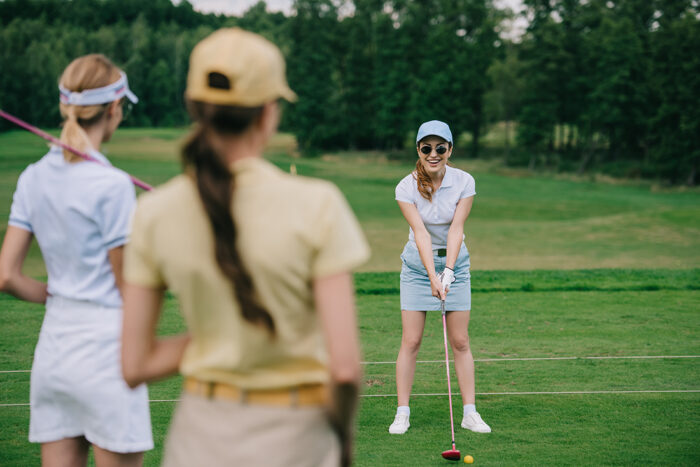How to attract and keep more female golfers at your course
LPGA Master instructor Kiran Kanwar PhD welcomes the huge growth in women who play golf in the last three years but asks a vital question – for how long will they keep playing?
Are women in general interested in golf? How many women currently even play the sport? An answer may be found through the many organisations that track numbers of golfers. For instance, data shows that 20 percent of the 5.6 million golfers in the UK in 2022 were females.
According to the US’s National Golf Foundation, at about the same time 25 percent of on course golfers were female, up from 19 percent ten years ago.
This increase is probably, in no small part, due to dozens of organisations that have sprung up all over the world as stakeholders realise the monetary benefits of the inclusion of females to prop up the frequently fluctuating fortunes of golf. Interestingly, the growth is skewed towards beginner golfers (of whom 41 percent are female), juniors (37 percent) and off-course players (41 percent).
While the growing numbers of females playing golf is indeed heartening and paints a very promising picture, with more and more females entering golf, especially since the pandemic, few are addressing the elephant in the room. That of how long females are actually retained by the sport, and whether female golfers quit the sport and why.

To find any numbers on that topic, one has to look at an almost 20-year-old article on Golf Course Industry, ‘Why they quit the game’, published in 2004. It speaks only to the topic of golfers in general, not female golfers in particular. It states that while three million enter the game every year (in the USA), three million also leave. The article goes on to add that the three big myths surrounding the reason that golfers leave the game are that it is difficult to get a tee time, that it is too expensive and that it takes up too much time. The main reason golfers quit, the author opines, is that many golf courses are too hard.
‘Why do women opt out of playing golf’ is the title of an article that might shed some light on the question at hand, especially as it is by a female author (Jenn Harris in a LinkedIn post). In her opinion, some of the aspects of the game that might put women off are that, “People are too snooty at clubs, they feel like no men will want to play golf with them, because they think they won’t be good enough and because it just takes too much time to play the game. Oh and it’s also really expensive.” She believes that women should be convinced of the benefits of golf, such as the gorgeous weather and getting one’s daily step count in. These solutions are perhaps generation-specific and speak more to baby boomer females than millennials and gen zs, who know their own worth and will not be put off by snooty or disinterested club members.
One new online platform servicing the hospitality business (lightspeedhq.com) suggests various ideas that centre around the theme of hosting golf days and group golf lessons for women and girls and making sure they are discounted. Surely those are ideas that golf courses have already considered or even implemented for years?
The National Women’s Golf Alliance in the US actually inspects golf courses for women-friendliness and rates them on the playability of the golf course, the level of hospitality and their women-specific golf programmes. It is not known whether this organisation still exists, with a website that does not work. However, the many ideas of its founders are well thought out and deserve to be checked out (visit golfdom.com).
So here are some hard-hitting suggestions for golf course owners and managers who truly care about increasing the number of female golfers at their facilities:
Firstly, know the generational and socio-economic demographic of the females you wish to recruit to golf. Are you likely to offer quick golf with music, food and a party atmosphere? If not, your best target audience is the baby boomer female. Three things will help the most (besides the lower prices, the clean restrooms and female-preferred food choices, which should be a given).
1. Make your course fit the needs of your potential and existing female golfers. Not just in the hypothetical with forward tees, less forced carries and doglegs and fairways that slope towards advantageous locations. Specifically, you could offer a day of one-on-one free golf lessons for local female golfers. Your club pro could be provided with a simple questionnaire they would fill out.

The pro would measure, on a sophisticated launch monitor, 15 tee shots and 15 fairway shots with each golfer’s preferred club for each shot. Learn about the distance and directional dispersion patterns of your specific population, their carry and trajectory capabilities, and then hire a female golf course architect who can change some elements of your course to be truly relevant for your golfers.
2. Find a good club fitter who can make up a set for any female golfer that is both brand- and gender-agnostic and does not break the bank to acquire. Why did equipment manufacturing companies decide unilaterally that all female golfers need 15° drivers and irons, lots of wedges and pleasing pastel colours to make up the whole?
3. Teach them a female body-friendly golf swing. While women are usually very flexible, the more movement they have, especially of the legs, torso and head, the less likely they are to make authoritative-enough contact with the ball on a consistent basis to get much trajectory and thus much distance. What women need is a body that is very still and arms that have a wide arc, both of which have been researched to give female golfers better ball-flight.
It is possible to bring lots more female golfers into the game but it needs much more than the sometimes superficial, very stereotypical solutions that have usually been offered over the years.
LPGA Master instructor Kiran Kanwar has a PhD in kinesiology (biomechanics and anatomy) and wrote a thesis on causes of golf swing-related injuries. Kiran is also chair of Stanton University’s golf department. Visit her website www.YourGolfGuru.com















Actually, the reasons behind female golfers leaving aren’t too far off from the myths above, even though it doesn’t include the importance of member satisfaction.
Over the years, our surveys of female golf club members in England have brought in nearly 3000 responses about why some don’t believe they will remain club members in two years. Apart from age having the highest score, the top three reasons are as follows: not expecting to use the membership enough, finding the membership fees too expensive, and being dissatisfied with the club in general.
Would love to see your questionnaire
Our company name is Players 1st, and we share many of our findings on either LinkedIn or on our blog, so feel free to have a look.
Website:
https://players1st.sport/
LinkedIn:
http://www.linkedin.com/company/players-1st/